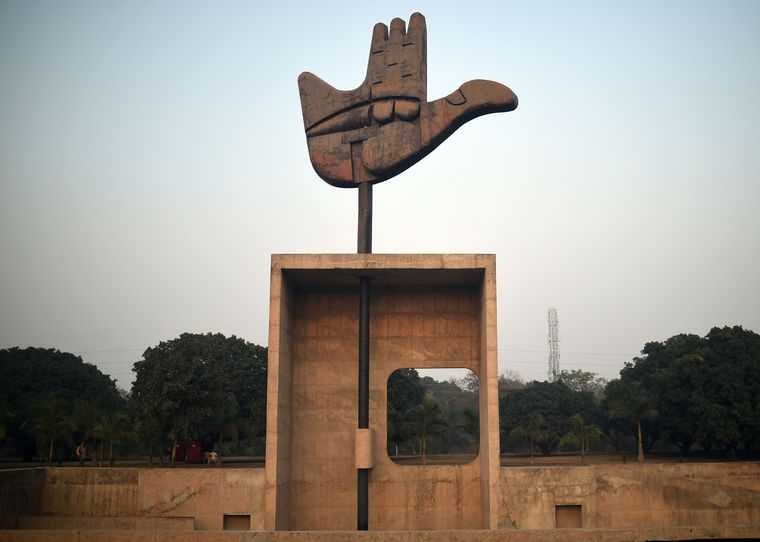Water has long been a cinematic staple. In Dune, it is a sacred resource on a desert planet. In Waterworld, it is both abundant and scarce―earth is a vast ocean with little drinkable water. Quantum of Solace sees James Bond battling terrorists over Bolivia’s water supply, while in Dr Strangelove, an unhinged general orders a nuclear strike, convinced that the communists are conspiring to poison America’s drinking water. In The Man Who Fell to Earth, an alien seeks water to save his dying planet. Avatar: The Way of Water captures its elemental power: “Water connects all things, light to death, darkness to light.”
It makes sense―water is the most consumed substance on earth. Yet, cinema has paid little attention to the world’s second most-used material: concrete. Or, as the French call it, béton brut―raw concrete.
The Brutalist is a rare entry in film’s sparse concrete canon. Adrien Brody, in his second Oscar-winning role, plays Laszlo Toth, a Holocaust survivor and visionary architect who leaves war-torn Europe for America. Early on, he wakes up in the belly of a ship entering New York Harbour. A voice orders him to prepare his papers. He gathers his few belongings and stumbles through a swarm of sweat-drenched passengers, all rushing towards the promise of a new beginning.

Toth has lost everything―his home, his family, his country. As he pushes through the crowd, slivers of sunlight pierce the ship’s narrow openings, illuminating his gaunt face. He steps on to the deck, engulfed in daylight. The music swells. A man stares skyward, overcome with joy. Toth follows his gaze―and there she is: rising from the water, impossibly tall, arm aloft, flame in hand. The Statue of Liberty.
Like Toth, Lady Liberty arrived in America in pieces―built in France, dismantled, packed into crates and ferried across the Atlantic to be reassembled atop a concrete pedestal. In that moment, Toth, too, believes in concrete―a builder ready to rebuild his life.
The Brutalist is a love letter to béton brut, where the material itself bears history in its textures and patterns. As a brutalist, Toth embodies an architectural movement that embraces the raw and the unadorned. Brutalist buildings are “honest” in their unfinished surfaces―hulking, geometric, monumental. They endure―and for Toth, endurance is everything. “My buildings were devised to endure the Danube’s erosion,” he says.
The film reflects concrete’s role in both the immigrant experience and the broader civilisational project. Postwar Europe turned to brutalism for large-scale, low-cost reconstruction―spawning courts, legislatures, universities, apartment blocks. By the 1950s, architects like Le Corbusier and Louis Kahn championed its stark, functional forms. Their influence, like raw concrete itself, flowed into India, where Jawaharlal Nehru’s vision of nation-building found expression in Corbusier’s work in Chandigarh and Kahn’s monumental Indian Institute of Management in Ahmedabad.
But, despite being the most widely used building material on earth―its consumption exceeding steel, wood, plastic and aluminium combined―béton brut has left little imprint on cinema. This is surprising, because concrete has long symbolised both utopia and dystopia.
In Utopia (1516), Thomas More imagined a world of order and permanence, with houses “covered with a kind of cement… cheap but so well mixed that it is impervious to fire”. To George Orwell, concrete was inevitable progress. “On the one side, science, order, progress, internationalism, aeroplanes, steel, concrete, hygiene; on the other side, war, nationalism, religion, monarchy, peasants, Greek professors, poets, horses.”

J.G. Ballard, however, saw it as a dystopian trap. In Concrete Island (1974), an architect crashes his car and finds himself stranded at a derelict junction of three highways. “A gigantic concrete bullring, open to the sky, without exits!” The island becomes his prison, as speeding cars obliviously pass him by. “Nothing can change, nothing can evolve… surrounded only by a world of dead concrete.”
A few films have placed concrete at their core. In Locke (2013), Tom Hardy’s character, a construction manager, oversees a delicate 250-truck concrete pour for a skyscraper while confronting a personal crisis. “You do it for the piece of sky we are stealing with our building,” he tells a subordinate. “You do it for the air that will be displaced, and most of all, you do it for the f*ing concrete. Because it is delicate as blood.”
More often, concrete in pop culture is cold and brutal. Dragged Across Concrete (2018), a thriller about two suspended cops, even won a Razzie for “Worst Reckless Disregard for Human Life and Public Property.”
It does not help that concrete is not ecologically reputable―it is a major cause of global warming. Last year, Francis Ford Coppola released Megalopolis, an epic sci-fi drama about a genius architect who dreams of a futuristic city. He invents Megalon, a miraculous metal designed to replace concrete. His enemies, the city’s corrupt elite, fight him to preserve the status quo. “Megalon is not safe,” one of them sneers. “Concrete, concrete, concrete, and steel, steel, steel are safe. Cha-ching!”
The Brutalist offers a more nuanced view of concrete. The word “concrete” comes from the Latin concrescere, meaning “to grow together”. Toth sees his buildings as machines without superfluous parts, with an immovable concrete heart―“a hard core of beauty”.
Concrete shapes how people inhabit spaces, bringing them together to live and grow. It can divide, too―walls are built to separate communities. But often such projects, like Donald Trump’s Mexico border wall, are never completed. In its way, the béton brut in The Brutalist mirrors the immigrant experience. Like water―and like Toth and Lady Liberty―it finds a way around barriers. As Le Corbusier wrote: “Architecture is, with raw materials, establishing moving and renewing relationships.”


